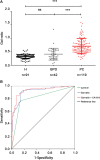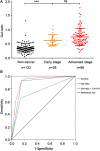Diagnostic Significance of Serum IgG Galactosylation in CA19-9-Negative Pancreatic Carcinoma Patients
- PMID: 30873386
- PMCID: PMC6402387
- DOI: 10.3389/fonc.2019.00114
Diagnostic Significance of Serum IgG Galactosylation in CA19-9-Negative Pancreatic Carcinoma Patients
Abstract
Background: Although Carbohydrate antigen 19-9 (CA19-9) is considered clinically useful and informative for pancreatic carcinoma (PC), false positive results, and false negative results have restricted its clinical use. Especially missed or delayed diagnosis of PC patients with negative CA19-9 value limited the utility. To improve prognosis of PC patients, the discovery of reliable biomarkers to assist CA19-9 is desired. Serum IgG galactosylation based on our previous report was altered in PC patients comparing to healthy controls. The objective of this study was to explore the diagnostic significance of IgG galactosylation in assisting CA19-9 for PC in a comprehensive way. Methods: Serum IgG galactosylation profiles were analyzed by MALDI-MS in cohort 1 (n = 252) and cohort 2 in which all CA19-9 levels were negative (n = 133). In each cohort, not only healthy controls and PC patients but also benign pancreatic disease (BPD) patients were enrolled. Peaks were acquired by the software of MALDI-MS sample acquisition, followed by being processed and analyzed by the software of Progenesis MALDI. IgG Gal-ratio, which was calculated from the relative intensity of peaks G0, G1, and G2 according to the formula (G0/(G1+G2×2)), was employed as an index for indicating the distribution of IgG galactosylation. Results: The Gal-ratio was elevated in PC comparing with that in non-cancer group (healthy controls and BPD). The area under the receiver operating characteristic curve (AUC) of IgG Gal-ratio was higher than that of CA19-9 (0.912 vs. 0.814). The performance was further improved when Gal-ratio and CA19-9 were combined (AUC: 0.928). Meanwhile, Gal-ratio also had great diagnostic value with a sensitivity of 92.31% (AUC: 0.883) in detection of PC at early stage. Notably, IgG Gal-ratio has great sensitivity (90.63%) and specificity (76.81%) in CA19-9-negative PC patients. Conclusions: IgG Gal-ratio had a great performance in detection of PC and could be used to assist CA19-9 in improving diagnosis performance through early stage detection, differentiation from BPD, and PC diagnosis with CA19-9-negative level.
Keywords: CA19-9; IgG; diagnostic biomarker; galactosylation; pancreatic carcinoma.
Figures




Similar articles
-
Alteration of Serum IgG Galactosylation as a Potential Biomarker for Diagnosis of Neuroblastoma.J Cancer. 2018 Feb 25;9(5):906-913. doi: 10.7150/jca.22014. eCollection 2018. J Cancer. 2018. PMID: 29581769 Free PMC article.
-
Serum miR-1290 and miR-1246 as Potential Diagnostic Biomarkers of Human Pancreatic Cancer.J Cancer. 2020 Jan 1;11(6):1325-1333. doi: 10.7150/jca.38048. eCollection 2020. J Cancer. 2020. PMID: 32047539 Free PMC article.
-
Pancreatic cancer serum biomarker PC-594: Diagnostic performance and comparison to CA19-9.World J Gastroenterol. 2015 Jun 7;21(21):6604-12. doi: 10.3748/wjg.v21.i21.6604. World J Gastroenterol. 2015. PMID: 26074698 Free PMC article.
-
Diagnostic value of serum carbohydrate antigen 19-9 in pancreatic cancer: a systematic review and meta-analysis.Eur J Gastroenterol Hepatol. 2022 Sep 1;34(9):891-904. doi: 10.1097/MEG.0000000000002415. Epub 2022 Jul 27. Eur J Gastroenterol Hepatol. 2022. PMID: 35913776
-
Carbohydrate antigen 19-9 for differential diagnosis of pancreatic carcinoma and chronic pancreatitis.World J Gastroenterol. 2015 Apr 14;21(14):4323-33. doi: 10.3748/wjg.v21.i14.4323. World J Gastroenterol. 2015. PMID: 25892884 Free PMC article. Review.
Cited by
-
Prediction of neoadjuvant chemotherapeutic efficacy in patients with locally advanced gastric cancer by serum IgG glycomics profiling.Clin Proteomics. 2020 Feb 6;17:4. doi: 10.1186/s12014-020-9267-8. eCollection 2020. Clin Proteomics. 2020. PMID: 32042279 Free PMC article.
-
Complementary Use of Carbohydrate Antigens Lewis a, Lewis b, and Sialyl-Lewis a (CA19.9 Epitope) in Gastrointestinal Cancers: Biological Rationale Towards A Personalized Clinical Application.Cancers (Basel). 2020 Jun 9;12(6):1509. doi: 10.3390/cancers12061509. Cancers (Basel). 2020. PMID: 32527016 Free PMC article. Review.
-
Identifying Novel Biomarkers Ready for Evaluation in Low-Prevalence Populations for the Early Detection of Upper Gastrointestinal Cancers: A Systematic Review.Adv Ther. 2021 Feb;38(2):793-834. doi: 10.1007/s12325-020-01571-z. Epub 2020 Dec 11. Adv Ther. 2021. PMID: 33306189 Free PMC article.
-
N-glycosylation in non-invasive and invasive intraductal papillary mucinous neoplasm.Sci Rep. 2023 Aug 14;13(1):13191. doi: 10.1038/s41598-023-39220-4. Sci Rep. 2023. PMID: 37580349 Free PMC article.
-
Application of Mass Spectrometry in Pancreatic Cancer Translational Research.Front Oncol. 2021 Oct 11;11:667427. doi: 10.3389/fonc.2021.667427. eCollection 2021. Front Oncol. 2021. PMID: 34707986 Free PMC article. Review.
References
LinkOut - more resources
Full Text Sources

